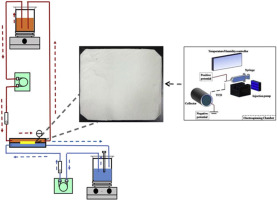Water Research ( IF 11.4 ) Pub Date : 2018-02-10 , DOI: 10.1016/j.watres.2018.02.011 Long-Fei Ren , Mister Adeel , Jun Li , Cong Xu , Zheng Xu , Xiaofan Zhang , Jiahui Shao , Yiliang He

|
Phenol recovery from phenol-laden saline wastewater plays an important role in the waste reclamation and pollution control. A membrane aromatic recovery system-like membrane contactor (MARS-like membrane contactor) was set up in this study using electrospun polydimethylsiloxane/polymethyl methacrylate (PDMS/PMMA) membrane with 0.0048 m2 effective area to separate phenol from saline wastewater. Phenol and water contact angles of 0° and 162° were achieved on this membrane surface simultaneously, indicating its potential in the separation of phenol and water-soluble salt. Feed solution (500 mL) of 0.90 L/h and receiving solution (500 mL) of 1.26 L/h were investigated to be the optimum conditions for phenol separation, which corresponds to the employed Reynolds number of 14.6 and 20.5. During 108-h continuous separation for feed solution (2.0 g/L phenol, 10.0 g/L NaCl) under room temperature (20 °C), 42.6% of phenol was recycled in receiving solution with a salt rejection of 99.95%. Meanwhile, the mean phenol mass transfer coefficient (Kov) was 6.7 × 10−7 m s−1. As a membrane-based process, though the permeated phenol increased with the increase of phenol concentration in feed solution, the phenol recovery ratio was determined by the membrane properties rather than the pollutant concentrations. Phenol was found to permeate this membrane via adsorption, diffusion and desorption, and therefore, the membrane fouling generated from pore blockage in other membrane separation processes was totally avoided.
中文翻译:

膜芳烃回收系统样膜接触器通过超疏水/亲有机电纺PDMS / PMMA膜从含酚盐水废水中分离苯酚
从含苯酚盐废水中回收苯酚在废物回收和污染控制中起着重要作用。在这项研究中,建立了一种膜芳烃回收系统样膜接触器(MARS类膜接触器),该膜接触器使用的静电纺丝聚二甲基硅氧烷/聚甲基丙烯酸甲酯(PDMS / PMMA)膜为0.0048 m 2从盐水中分离出苯酚的有效区域。同时在该膜表面上获得了0°和162°的苯酚和水接触角,表明其在分离苯酚和水溶性盐中的潜力。研究了0.90 L / h的进料溶液(500 mL)和1.26 L / h的接收溶液(500 mL)是分离苯酚的最佳条件,其对应的雷诺数分别为14.6和20.5。在室温(20°C)下连续分离进料溶液(2.0 g / L苯酚,10.0 g / L NaCl)108小时后,42.6%的苯酚在接收溶液中再循环,脱盐率为99.95%。同时,平均苯酚传质系数(K ov)为6.7×10 -7 m s -1。作为一种基于膜的方法,尽管渗透的苯酚随进料溶液中苯酚浓度的增加而增加,但苯酚的回收率是由膜的性质而不是污染物的浓度决定的。发现苯酚会通过吸附,扩散和解吸作用渗透到该膜中,因此,完全避免了其他膜分离过程中由于孔堵塞而引起的膜污染。


















































 京公网安备 11010802027423号
京公网安备 11010802027423号